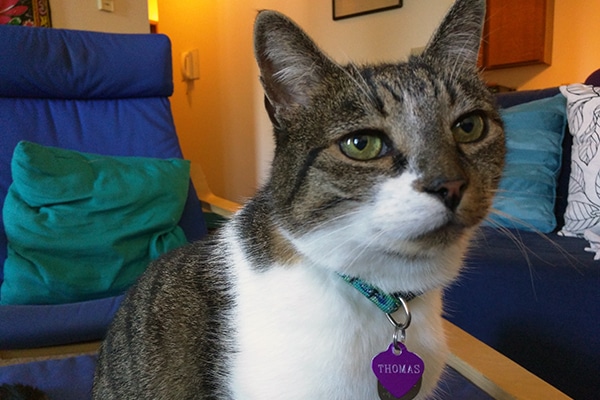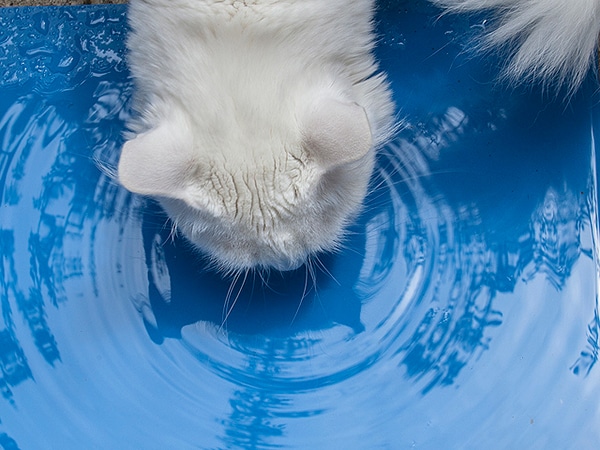As you might have read in my most recent article, my 15-year-old cat, Thomas, was recently diagnosed with chronic kidney disease.
The bad news? The condition is incurable. The good news? There’s plenty that can be done to manage chronic kidney disease, or CKD, and give your cat a very good quality of life for years. Here’s the 411 on feline kidney disease.

Symptoms
The main thing you’ll notice in a cat with CKD is that he drinks a lot of water, and as a result, he pees a lot. If you notice your cat emptying his water bowl and filling his litter box, it’s time to visit your vet. Thomas’ excessive drinking and urination got me to the vet.
Other symptoms, according to the Cornell Feline Health Center, include weight loss, decreased appetite, lethargy, and, in some cases, vomiting. These symptoms are typically due to a buildup of toxins in the blood.

Diagnosis
CKD is diagnosed with blood work and a urinalysis. The blood work measures the concentration of certain compounds in the blood that should be in the urine, chief among which are creatinine and blood urea nitrogen, or BUN. When the creatinine level is high, that means the kidneys are not effectively filtering out this chemical. A high BUN indicates some level of dehydration, which is pretty common in cats with chronic kidney disease.
In Thomas’ case, his creatinine level went from 2.6, which, according to my vet, is within the normal range for a cat of his age, to 3.5. This big jump put him into Stage III kidney disease.
The urinalysis will provide other insights into the level of kidney function. If the urine is very dilute or if there is protein in the urine (proteinuria), that means the kidneys are not working well. That could result in changes in the urine pH (acid-alkaline balance), among other things. Unfortunately, we couldn’t get any urine for a urinalysis when I took Thomas in, since he had peed just before we left for the vet.
If your cat is diagnosed with CKD, your vet might also choose to take X-rays or do an ultrasound, or perhaps do a urine culture to determine whether an infection is creating the abnormal kidney function shown in the blood and urine.
Cats with kidney disease may have high blood pressure as well.
A new blood test, the SDMA, might be able to detect kidney disease earlier than standard blood chemistry tests.

Treatment
As I mentioned earlier, CKD is not curable. However, there are things you and your vet can do to make your cat’s life better.
The first of these is subcutaneous fluids. Giving subcutaneous fluids involves sticking a needle under the skin at the back of the neck and giving a small amount of electrolyte-containing fluids to help filter toxins out of the blood. Because Thomas is maintaining a good hydration level by drinking lots of water, I don’t have to give subcutaneous fluids yet.
Medications might be given to manage symptoms such as nausea and high blood pressure in order to maintain health.
Your vet might recommend a change in diet and vitamin supplements as well. There are prescription foods available that help to provide the appropriate level of protein and vitamin supplements. At this point, my vet has not recommended a diet change because Thomas is maintaining his weight on his current diet, which is important in a cat with kidney disease.
Dialysis and kidney transplants are available for cats with advanced kidney disease, but these treatments are often hard to find and cost-prohibitive for many cat guardians.

Coping
The hardest thing for us humans is knowing that our cats with kidney disease don’t have a curable condition, and that the disease is probably going to shorten their lives pretty significantly. The best thing you can do is work very closely with your vet.
The next thing to do if you find out your cat has chronic kidney disease is to seek support forums and reputable websites such as Tanya’s Comprehensive Guide to Feline Chronic Kidney Disease. I’ve gotten lots of good information from Tanya’s Comprehensive Guide, including how-tos on giving subcutaneous fluids for when Thomas’ disease reaches that stage.
Do you have a cat with chronic kidney disease? What treatments have you used, and what ways of coping have you found work best for you? I want to know, not just for Thomas’s and my sake but for the sake of all cats with CKD.








